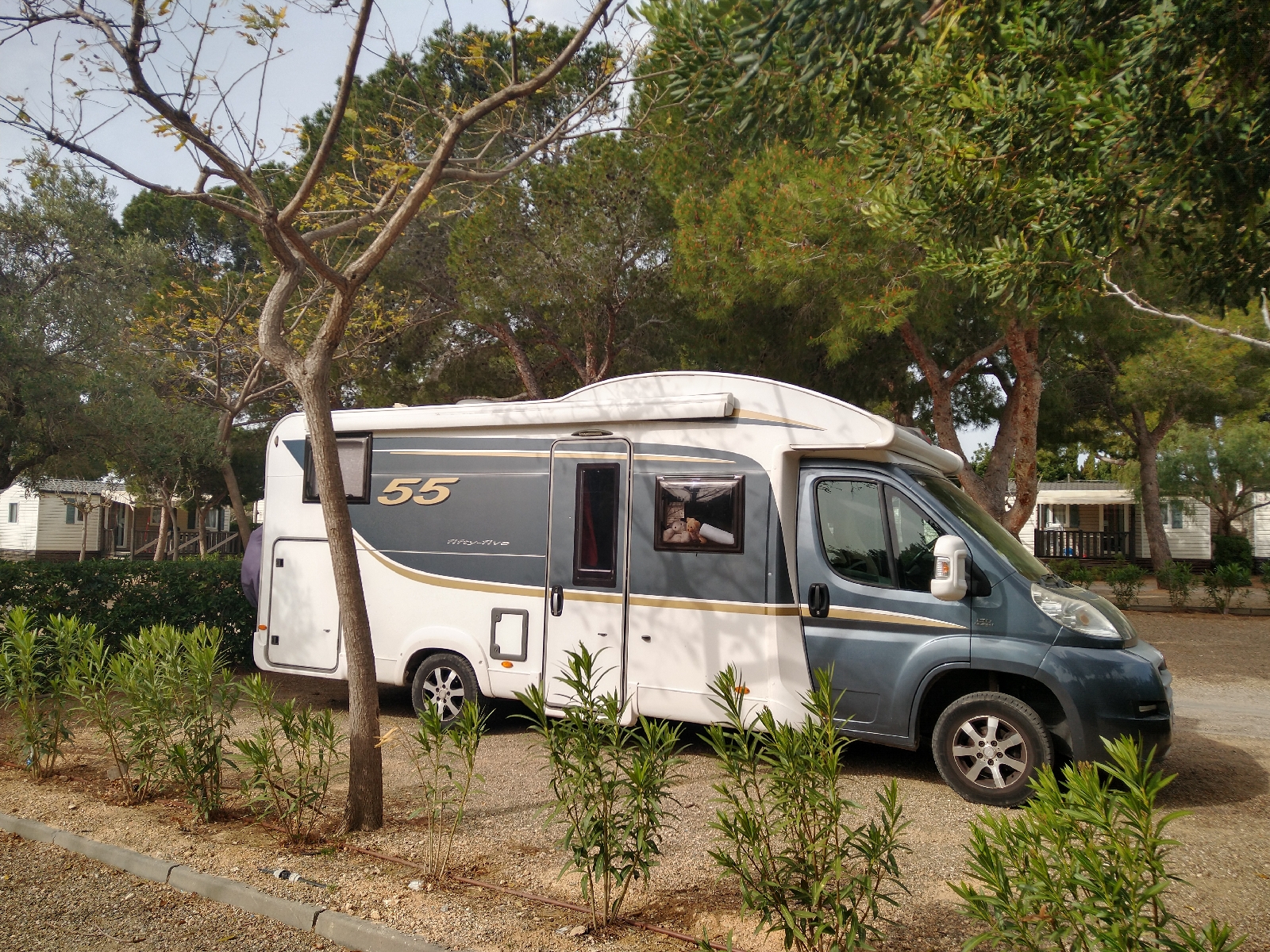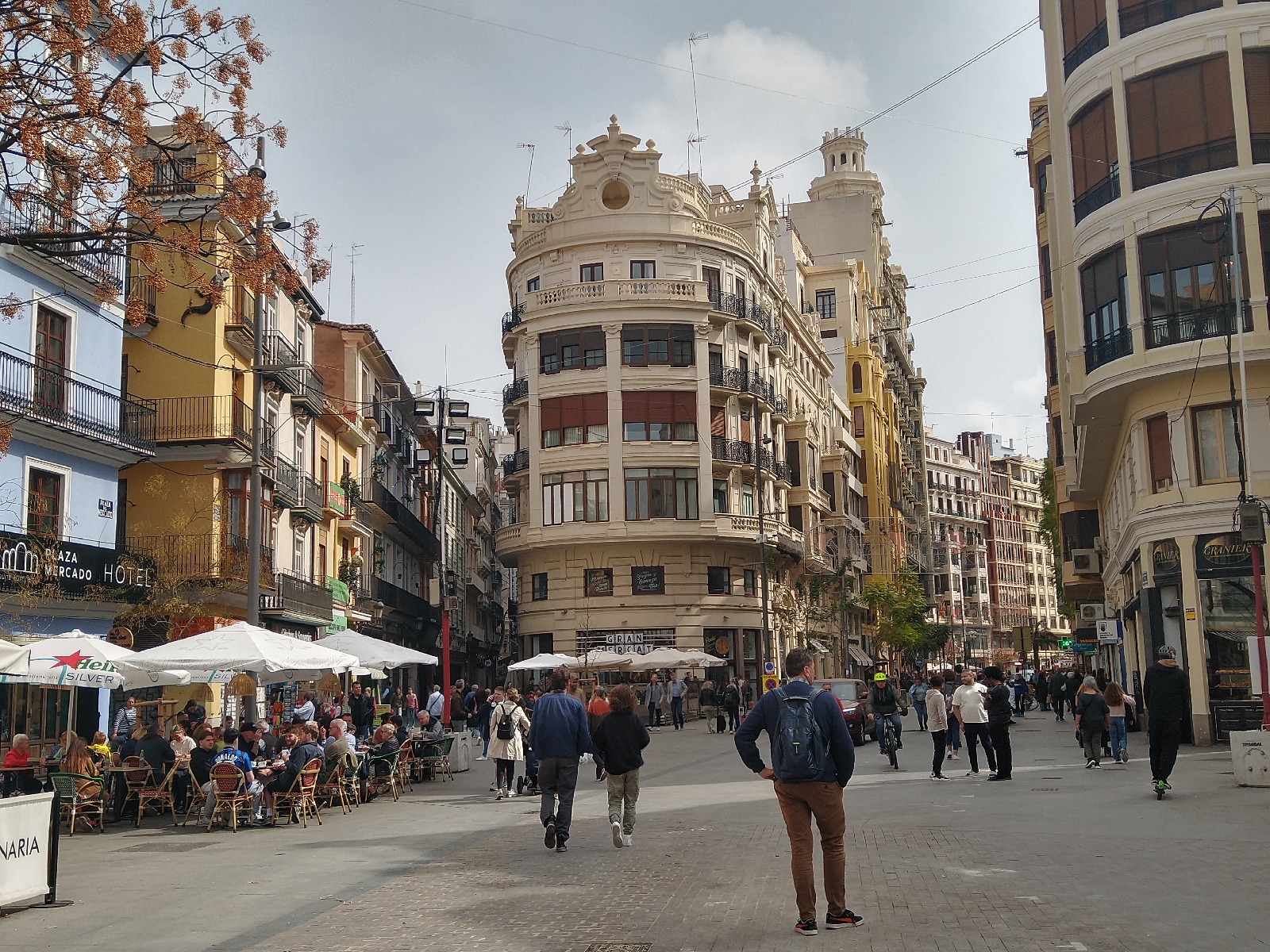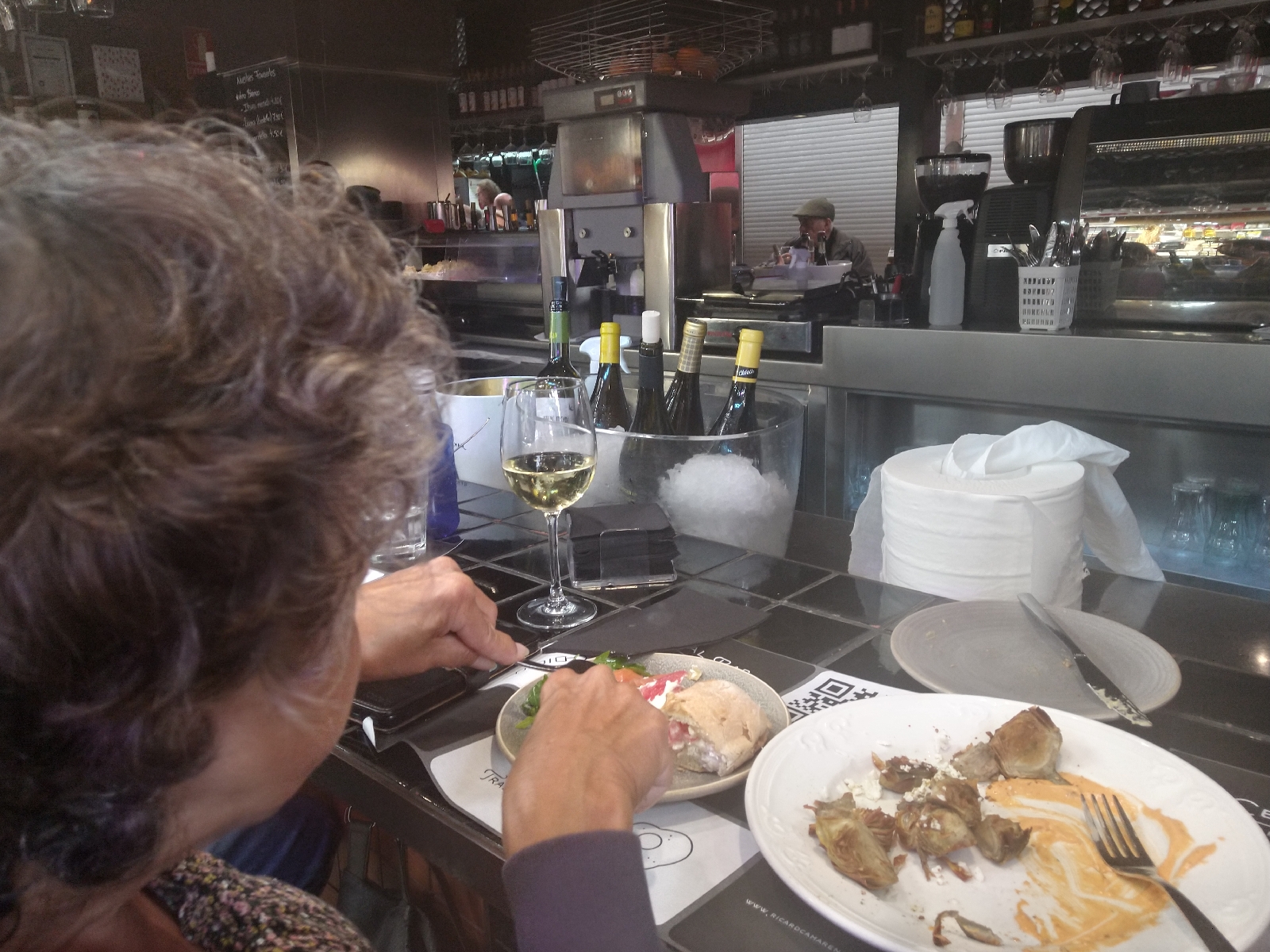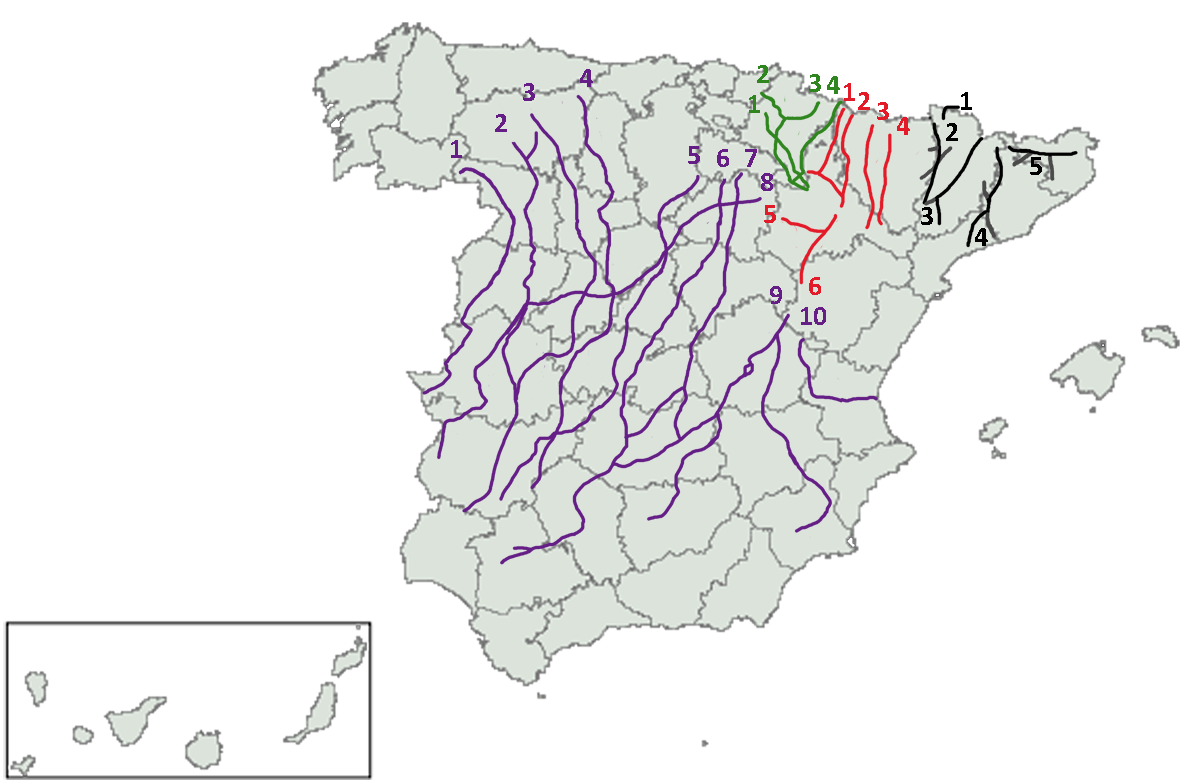Not for the first time the crowded sites on the coast started to get us down. We never intended to go to Punta del Calnegre or Isla Plana in the first place. Our plan from Gibraltar had been to head to Ronda then west towards Granada then spend a few days at a campsite next to the Embalse de Negratin where I could practice falling off my paddle board. The lake is also close to a Via Verde which we haven't cycled yet, so it looked a good place to stay for a week or so. Sadly the weather forecast was abysmal throughout Andalusia. We spent two days in the site at Beas de Granada watching the rain pour down. Things looked more promising towards Cartegena and Murcia so we ended up on the busy coastal sites instead.
Though the weather was forecast to be fine for another couple of days here, the outlook was changeable, blustery with the chance of being enveloped by a Saharan dust cloud. The outlook further north around Valencia looked better. So we hatched a plan, a couple of days around Mula and Bullas to cycle the Via Verde de Noroeste again, then north past Elche to Alcoi. I had marked on our map the route of another via verde near there that we hadn't cycled yet with a free area autocaravanas next to it.
However, it's rare for anything to go exactly to plan. Mula is a small town in the barren hills west of Murcia. A ruined Moorish castle sits on top of a pointy hill, the town spread out around it's foot. From the area autocaravanas in the corner of the sports centre car park to town itself looks somewhat unprepossessing, though
lemon tree orchards surround the place and the urban outskirts dotted with smallholdings among drab concrete apartment blocks.
There were about eight other motorhomes spread about in the big car park, busier than last year but not overcrowded like the coastal sites. We off-loaded the bikes and set off down the nearby trail. It's a dramatic rocky landscape, the bleakness softened by big citrus fruit plantations and acres of olive trees.
Murcia and eastern Andalusia are suffering month's long drought. It's a dry climate under normal circumstances so the lack of rainfall in the mountains in the autumn and early winter have turned a chronic issue into an acute one.
Nevertheless there is still large scale planting going on, young olive trees set in long strips of black plastic with irrigation pipes running the whole length. How can that be sustainable? The new plantations looked spectacular creating liquorish allsorts style stripes across the chalky white hills.
The bike ride proved tricky from my point of view, underlining the extent to which my condition has deteriorated over the past year. The trail was rough, the compacted surface potholed and ridged by agricultural vehicles that share the via verde with cyclists.
It was no different last year but I have had two surgical procedures affecting my lower abdomen in the last few months and I found the trail challenging. I hope things improve slowly over time, getting out and about on our bikes on traffic free routes is something we love doing. For that to be curtailed would be a sad thing.
However, our return trip to Mula was not just about the trail. When we came here last year we didn't visit the town. From the area autocaravanas the castle looks spectacular but the town nothing special. When I looked on Google Maps one place stood out. With a review score of 4.8 the Museo de Arte Ibérico El Cigarralejo came out as the town's top attraction. I like well curated small museums and after the profoundly underwhelming one in Gibraltar I felt I was 'owed'.
The centre of town was a 20 minute walk from the area autocaravanas. The outskirts of Mula were a bit drab but the town centre more attractive than we anticipated.
The museum itself was great, showcasing finds from a nearby iron age Iberian settlement occupied continuously from the 7th to the 1st centuries BCE. In particular the grave goods from the necropolis were remarkably well preserved, the arid climate ensuring fragments of textiles and leather goods survived as well as metalwork and ceramics.
History is dominated by the written word. So far as the Mediterranean is concerned during the classical era our understanding has been shaped by accounts written by Greek and Roman writers. Much less is known about other major civilisations such as the Phoenicians or Etruscans. We understand even less about the native tribal cultures that coexisted with Greeks and Romans and what we do know is often based the views of Greeks and Romans themselves who regarded any other culture than their own as barbaric.
So the artefacts on display in the Museo de Arte Ibérico El Cigarralejo provide a fascinating insight into native Iberian people before the peninsula was absorbed into the Roman empire in the first century BCE.
The settlement was small - around fifty dwellings, a sanctuary and a necropolis. It was occupied for almost six centuries. Judging by the harnesses and bridles found in the tombs of the males, horses were central to the culture and possibly worshipped. Hundreds of small effigies of horses were discovered either modelled in clay or cast in bronze. Even today Spanish people venerate horses, especially in Roma culture. Maybe this connection stretches way back into prehistory.
The museum held hundreds of examples of the Iberian tribes' pottery. Typically the pieces were decorated with simple geometric patterns in a way that made them look quite modern.
The women's tombs yielded examples of finely wrought jewellery and small, delicate jars and pots for ointments, perfumes and cosmetics.
Fragments of fabrics also survived, enough to make a guess at their costume. Their headgear was tall and pointy, reminiscent of the traditional costumes found in the steppes of Eurasia today.
What also was unequivocally evidenced was the interconnectivity of ancient Mediterranean cultures. Examples of both Attic Red and Black figure vases were unearthed from the necropolis, traded via Phoenician merchants presumably. Cartegena is less than 50 kms. away, and the network of trade routes controlled by the Phoenicians stretched from the Levant to Cornwall..
What was great about the place is how it communicated the richness and sophistication of the indigenous people of the Mediterranean whose stories had been reduced to mere footnotes in the works of ancient writers. The place was full of surprises, such as the fact that Iron Age Iberian tribes were literate, their inscriptions using an alphabet that looked almost runic.
So, a great way to spend an hour or so on a Saturday morning. By the time we left the museum we were feeling much more positive about Mula. The museum is located in a grand seventeenth century mansion. Clearly the town was once more important than today, but even today we noticed a sense of civic pride about the place.
We walked across a brand new public garden with big raised beds faced with beautifully decorated tiles. The planting was so recent that some of the shrubs still had name tags on them. It was immaculate apart from one empty crisp packet littering the pristine pavement. As a newly adopted good citizen of Mula I headed straight for the offending object and put it in the bin.
We had lunch back at the van then headed 25kms west along the motorway to Bullas.
We stayed in the town's municipal campsite last year. It's basic, badly maintained but very cheap!
As for the town itself it's scrappy but industrious. As well as firms serving the needs of the local fruit farms there are lots of light engineering works too. However the place is mainly known for the local red and white wines produced from monastrell grapes. The terroir achieved DO status in 1996 and it's growing reputation was rewarded in 2021 when the town was given the accolade of being Spain's 'gastronomic capital' for that year.
Unlike the coastal campsites crowded with grey-haired seasonal migrants from colder climes the few that are open inland are largely unfrequented in the winter apart from at the weekend. Like in Italy many families in Spanish urban areas live in apartments with no outside space. Parking an elderly caravan in a seasonal plot on some unloved site in the nearby countryside is popular in both countries. Equally popular is attaching rickety gazebos or haphazard tarpaulin awnings to the ancient caravan then filling the rest of the pitch with ramshackle plywood storage huts or outside kitchens.
It gives the sites a favella vibe which looks dismal during the week when empty but comes alive from Friday to Sunday when people exit the cities to party at the weekend under the stars.
The Bullas campsite reception did not reopen after lunch until 4pm, and being rural Spain in practice this meant twenty minutes after then. We were parked outside the gates. Gill kept hopping out at regular intervals; slowly small gaggle of us gathered more in hope than expectation. Gill befriended a large locust sunbathing on the reception outside light. It was big enough to adopt as a pet.
By fiveish we had settled in. The regulars in the nearby seasonal pitches, roused from an extended siesta, entered into a frenzy of parcelas improvements, fixing up flappy bits on their gazebo, re-roofing the outside kitchen shack. This required an impressive array of power tools - shrieking circular saws, mini-drills and thudding nail guns.
After a short lull it was time for our neighbours to prepare their evening meal. Clearly questions concerning how to BBQ a steak or when and how to add ingredients to a paella pan matter a lot to Spanish people, for they were hotly and very loudly debated. The decibels did not diminish when they sat down to eat. If anything the cacophony notched up a bit. There was no perceivable order to the conversation, everyone talked over one another at full volume. It appeared there were only two middle aged couples next to us but it sounded like a small tribe. One of the women had a cackling laugh as if auditioning for the role of the bad fairy in an amateur dramatic society's attempt at Sleeping Beauty. As the evening progressed they became ever louder. It's the way it is, we are 'travellers in a foreign land'. I suspect people from other countries find the English spookily quiet.
Next morning it was very peaceful. Nothing happens in Spain on a Sunday morning, there seems to be a big national lie-in. We discovered the local store was open - Sunday opening for food shopping is rare in Spain. We used the shop last year, it's brilliant, a mixture of supermarket, ironmonger, garden centre and wine merchant hidden behind an innocuous looking corner shop frontage. It was heaving, a well loved social hub it would seem. We bought some bread and six more bottles of Bullas wine to supplement the ones we purchased yesterday.
Come early afternoon the campsite party was likely resume for an hour or two before the weekenders headed home. We decided to avoid the hubbub and took a walk through the public park next door. It had seen better days and was full of odd monuments and crumbling public buildings.
It wasn't very interesting so instead we went for a bike ride. The minor roads around Bullas are quiet, winding through an undulating valley full of almond trees. After the party vibe of the campsite it felt gloriously peaceful.
The area has a number of natural springs. We stopped to look at 'Pasico Ucenda'. Maybe after rain the 'fuente' is spectacular but with Murcia suffering months of drought the place marked on the map as a 'water feature' was all but dry. A few kilometres further on the road began to rise towards the Sierra Espuña. We decided to turn back.
I noticed a bare earth track snaking across the landscape taking a distinctly indirect route through the patchwork of almond orchards. It was marked by a big sign by the roadside but I was unable to stop as Gill was already some way ahead of me and I didn't want to risk becoming separated. All I noticed as I sped past was a picture of a shepherd with his flock and the words 'Via Pecuaria' - a drovers road I surmised.
When we got back to the van I managed to track down the sign on Google Streetview and checked out the meaning of 'Via Pecuaria'. It did translate as 'drovers road', but whereas in Britain these are now defunct ancient trackways in Spain they are still in use, 125,000km of them according to Wikipedia.
As you drive around Spain you are struck by the quality of its recently developed transport infrastructure. The main cities and towns are connected by motorways and dual carriageways built over the past four decades or so. Traffic jams are rare and as you speed across dramatic mountain landscapes and broad prairie-like plains you cannot fail to admire the country's high speed rail network. Often their tracks shadow the motorway, arrow straight across broad valleys on concrete pillars, tunnelling through cliff-faces, vanishing into deep cuttings hewn through solid rock. At 3,966km. Spain's HSR network is the second biggest in the world. Only China has more.
So it comes as a complete shock that as you drive down a quiet motorway somewhere in the emptiness of Extremadura or Castille la Mancha suddenly, on a dirt track separated from the inside lane by a flimsy chain link fence, you notice a big flock of sheep and goats straggling along accompanied by a lone shepherd and a scrawny dog of uncertain pedigree. It is as if time and space has become semi-permeable and a vision from the Neolithic momentarily inhabits the here and now.
,
However, what is really remarkable about these occasional visions of transhumance is they don't always happen in some remote spot. The 'via pecuarias' also skirt the edges of towns and cities.
We have often used the area autocaravanas in the corner of the Family Cash hypermarket on the outskirts of Osuna, a biggish town about 80km west of Seville. An area of scrubland separates the car park from the nearby A92 motorway. Twice we have watched one man and his dog drive a big flock of sheep between the carpark and the busy road then disappear into the olive tree dotted plain as they wander slowly towards the Sierra de los Caballos.
More remarkably a couple of years ago a similar scene occurred while we were cycling back from Aldi on the outskirts of Jerez. We were passing through a recently constructed retail area - supermarkets, car dealerships, a big gym and fitness centre, the kind of 21st century sprawl you find everywhere. On a vacant lot between a 'Brico' DIY superstore and a Hyundai dealership an enormous herd of goats appeared seemingly out of nowhere, with shepherd and trusty hound tagging behind. It seemed to take ages for the straggling line to disappear behind the car showroom. Then the world reverted to modernity and carried on as normal.
Parked in Costa campsite crowded with fellow geriatric migrants from northern climes it's easy to become a tad crestfallen about chasing the winter sun. Sometimes it just seems pointless, like running down the clock on purpose. This is only the case where you end up in touristy hotspots where visitors outnumber the locals Elsewhere Spain is fascinating, unique, alluring and almost always generous in it's welcome. You don't need to get off the beaten track to experience this, the extraordinary is couched in the mundane everywhere. It was a good move to run away from the coast and move inland to nowhere in particular. I am feeling much perkier.




























































